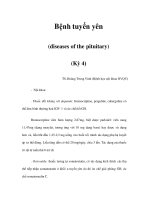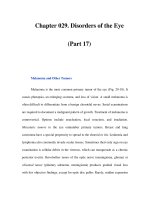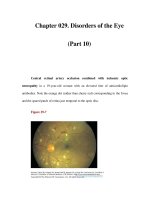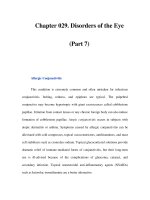Chapter 091. Benign and Malignant Diseases of the Prostate (Part 2) pot
Bạn đang xem bản rút gọn của tài liệu. Xem và tải ngay bản đầy đủ của tài liệu tại đây (49.29 KB, 5 trang )
Chapter 091. Benign and Malignant
Diseases of the Prostate
(Part 2)
Diagnosis and Treatment by Clinical State
The disease continuum—from the appearance of a preneoplastic and
invasive lesion localized to the prostate, to a metastatic lesion that results in
symptoms and, ultimately, mortality from prostate cancer—can span decades.
Management at all points is centered on competing risks that are defined by
considering the disease as a series of clinical states (Fig. 91-1). The states are
defined operationally, on the basis of whether or not a cancer diagnosis has been
established and, for those already diagnosed, whether or not metastases are
detectable on imaging studies and the measured level of testosterone in the blood.
With this approach, an individual resides in only one state and remains in that state
until he has progressed. At each assessment, the decision to offer treatment and the
specific form of treatment is based on the risk posed by the cancer, relative to
competing causes of mortality that may be present in that individual. It follows
that the more advanced the disease, the greater the need for treatment. For those
without a cancer diagnosis, the decision to undergo testing to detect a cancer is
based on the probability that a clinically significant cancer may be present. For
those with a prostate cancer diagnosis, the clinical state model considers the
probability of developing symptoms or dying from disease. Thus, a patient with
localized prostate cancer who has had all cancer removed surgically remains in the
state of localized disease as long as the PSA remains undetectable. The time
within a state becomes a measure of the efficacy of an intervention, though the
effect may not be assessable for years. As many men with active cancer are not at
risk for developing metastases, symptoms, or death, the states model allows a
distinction between cure—the elimination of all cancer cells, the primary
therapeutic objective when treating most cancers—and cancer control, in which
the tempo of the illness is altered and symptoms controlled until the patient dies of
other causes. These can be equivalent therapeutically from a patient standpoint if
the patient has not experienced symptoms of the disease or the treatment needed to
control it. Even when a recurrence is documented, immediate therapy is not
always necessary. Rather, as at the time of diagnosis, the need for intervention is
based on the tempo of the illness as it unfolds in the individual, relative to the risk-
to-benefit ratio of the therapy being considered.
No Cancer Diagnosis
Prevention
Several agents are under investigation for their potential to reduce the risk
of clinically significant prostate cancer. Finasteride, a 5α-reductase inhibitor, has
been tested in men ages ≥55 years in the Prostate Cancer Prevention Trial, a
double-blind, randomized multicenter trial. The prostate cancer detection rate was
18.4% (803 of 4364) in the finasteride group and 24.4% (1147 of 4692) in the
placebo group. Early concerns that the cancers detected in the finasteride group
were high-grade [37% (280 of 757 cancers) vs. 22% (237 of 1068 cancers) for the
placebo group] have been shown to be an artifact of the reduced volume of the
malignant epithelial cells in finasteride-treated patients. No effect on survival was
detected. Vitamin E and selenium are also being tested as preventive agents (the
SELECT study).
Physical Examination
The need to pursue a diagnosis of prostate cancer is based on symptoms, an
abnormal DRE, or an elevated serum PSA. The urologic history should focus on
symptoms of outlet obstruction, continence, potency, or change in ejaculatory
pattern.
The DRE focuses on prostate size and consistency and abnormalities within
or beyond the gland. Many cancers occur in the peripheral zone and can be
palpated on DRE. Carcinomas are characteristically hard, nodular, and irregular,
while induration may be due to benign prostatic hypertrophy (BPH) or to calculi
or tumor. Overall, 20–25% of men with an abnormal DRE have cancer.
Prostate-Specific Antigen
PSA is a kallikrein-like serine protease that causes liquefaction of seminal
coagulum. It is produced by both nonmalignant and malignant epithelial cells.
PSA is prostate-specific, not prostate cancer–specific, and serum PSA increases
may occur from prostatitis, BPH, and prostate cancer. The performance of a
prostate biopsy can increase PSA levels up to tenfold for 8–10 weeks. The serum
PSA level is not affected by DRE. PSA circulates in the blood as an inactive
complex with the protease inhibitors α
1
-antichymotrypsin and β
2
-macroglobulin,
and it has an estimated half-life in serum of 2–3 days. Levels should be
undetectable if the prostate has been removed. Immunohistochemical staining for
PSA can be used to establish a prostate cancer diagnosis.
PSA testing was approved in 1994 for early detection of prostate cancer,
but there is controversy on its use. The American Cancer Society recommends that
physicians offer PSA testing and a DRE on an annual basis for men over age 50
with an anticipated survival of >10 years; this includes men up to age 76 years.
For African Americans and men with a family history of prostate cancer, testing is
advised to begin at age 45. The American Urologic Association recommendations
are similar, with a proviso that the risks and benefits of the performance of these
tests are not defined. The National Comprehensive Cancer Network advises
testing at age 40, tailoring additional testing to the age-specific median. The
American College of Physicians recommends that physicians "describe the
potential benefits and known harms of screening" and to "individualize the
decision to screen." PSA values may fluctuate for no apparent reason; thus, an
isolated abnormal value should be confirmed before proceeding with further
testing.









